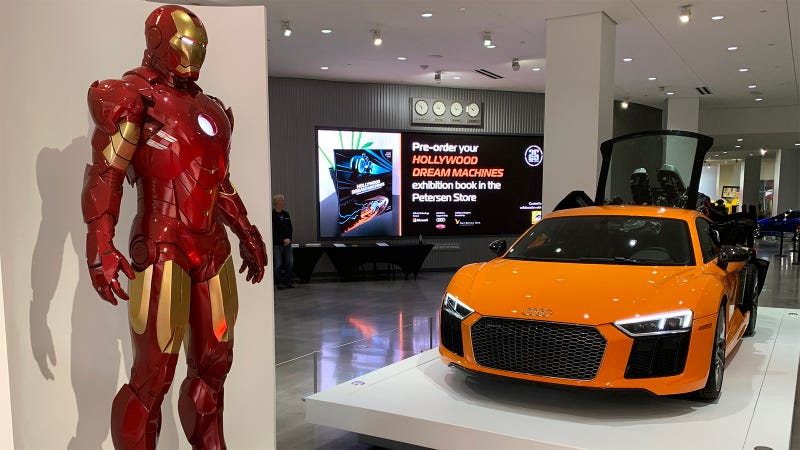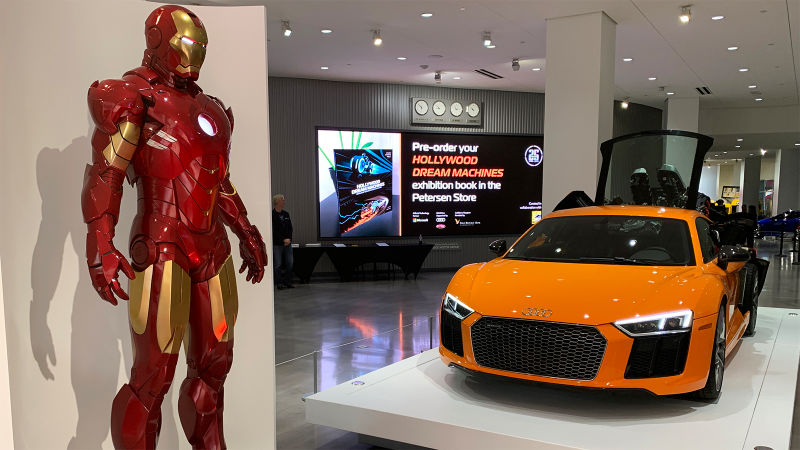
Our standard for what makes a movie stunt impressive is pretty high these days. But there’s another major factor that makes it hard to have crazy car action in today’s movies–the inherent idiosyncrasies of modern cars themselves.
Los Angeles’ Petersen Museum opened its incredible movie car exhibit, Hollywood Dream Machines, on Saturday with a party and a panel of people who had worked to coordinate and design cars in some of the best-known movies and TV shows from the last few decades. Among them was Dennis McCarthy, a Motion Picture Car Coordinator for Black Panther, Captain Marvel, and a whole bunch of the Fast & Furious films.

McCarthy brought up Black Panther because the Lexus 500 F Sport that the company paid a lot of money to be in the movie was a huge pain to do big, beautiful Hollywood powerslides in.

Advertisement
“These cars are made to do everything that’s not a car stunt,” McCarthy said. He explained that he’s been dealing with cars on camera long enough to know that, now, it’s important to ask the people providing a modern car for movie stardom, or in this case product placement, to send it with a computer programmer to deal with its litany of safety systems.
“With modern cars, you pull a headlight bulb out, the car won’t run,” McCarthy joked, but his point was corroborated by Josh Hancock, who’s also in the movie car business. Hancock added that the production of Baby Driver had to fly a technician in from Germany to make a Mercedes S-Class slide around and crash through a fence in the face-off with Jon Hamm,without shutting itself down.
Apparently it was aso a particularly massive pain to make the Lamborghini Murciélago drive “on ice with two inches of water” in The Fate Of The Furious.
Advertisement

“We bought manual transmission cars because it was easier to disable the traction control and ABS. And we went through clutches like crazy… I had to fly a guy in from London with about five clutches who was a Lamborghini tech to change the first one and teach my guys how to do it,” McCarthy explained.
He admitted that cooking clutches wasn’t really the car’s fault, but reiterated that a lot of the vehicles you see in movies are built in a rush, or scratch built, or semi-dismantled and the modern safety systems hate to let the cars work correctly, or wildly, when they’re missing seats or airbags or other systems.
Advertisement
Hancock said McCarthy had dropped more Chevy 350 crate engines in cars than anybody, to get around those problems. McCarthy responded with a chuckle.
“If I get frustrated we just throw an LS chevy motor in and it solves the problem… I get a lot of hate mail for that.”
But regardless of how hacked-up or hacked-into a movie car might be under its movie makeup, McCarthy said that he liked tying Fast & Furious cars to the characters who drive them. His thinking is that if you see a hero car on screen, the fans should know whose it is before the door opens and an actor gets out.
Advertisement
Vin Diesel’s Dominic Toretto is the hardest to do this for, McCarthy added.
“It’s always going to be a Charger,” apparently, but McCarthy explained that keeping that fresh was getting harder. He wouldn’t go into too much detail about Toretto’s car in the next movie, but did describe it as having a “European LeMans feel… something different we haven’t done yet.” As of this writing, the design was in early stages, and that’s all the Car Coordinator would say on the subject.
He also talked about product placement, and how he tried to avoid committing to cars as advertising in the Fast & Furious movies since the films are so vehicle-centric. “…the key to product placement is it has to be organic,” said McCarthy. “You don’t want to place the wrong car with the wrong person just because there’s money behind it… with the Fast & Furious, given that it’s a really car-driven franchise, we never do that,” quickly adding, “I’ll say 99 percent of the time we never do that”.
Advertisement
But not every project is like that. Visual Effects Art Director Michael Scheffe said that sometimes the cars in the films have to satisfy the people paying the studious a lot of money for them. Take KITT from Knight Rider, for example, which had to receive the approval of Pontiac.

“When we built that car, we were really careful to try and keep the feeling of the design,” he said, talking about how the production wanted to leverage the Pontiac’s appearance in the show. “Part of our brief [on designing KITT] was to redesign [the Firebird’s] front end and the interior in a way that Pontiac would say ‘Yeah, OK great’ because we wanted to be able to get these cars for free from Pontiac,” Scheffe explained.
Advertisement
Bob Gale, co-creator, co-writer and co-producer of Back To The Future, talked about how that movie kind of went the opposite way. The DeLorean was actually director Bob Zemeckis’s idea, which occurred to him as the movie’s production was going on at the same time as John Z. DeLorean’s trial. Obviously, the DeLorean Motor Company wasn’t in a position to be writing product-placement checks at that time, see as how it was already out business by then. The car being in the movie was a mostly creative, slightly practical decision.
And actually, Doc Brown’s time machine was written in the first two drafts of the Back To The Future script as a fridge toted around in the bed of a pickup truck. When practical considerations made the filmmakers change it to a car, Ford apparently offered $75,000 to the studio if they would use a Mustang.

Advertisement
But as Gale told the story, he wasn’t having it.
“Doc Brown doesn’t drive a friggin’ Mustang.”
But there are also the rare cases where an actor brings the idea of a certain vehicle to the table, like Austin Powers’ Jaguar XKE. Out of six storied Hollywood panelists, only Hancock could come up with an example of an actor seriously influencing a car-casting decision. Apparently Mike Myers had a Corgi model of a Jaguar E-Type and really wanted one in the movie, but Hancock, tasked with finding one, was coming up empty.
Advertisement
He finally did track down a left-hand drive XKE, got it converted to right-hand drive since the driving scene was supposed to be in England, and found someone to paint the Union Jack all over it at a big discount because they happened to be a big Mike Myers fan.

The Shaguar didn’t make it into the Petersen’s Hollywood Dream Machines exhibit, but the museum does have 53 actually-used-on-camera prop vehicles from films, shows and video games in a space decorated with gloriously immense storyboard prints from Blade Runner, Mad Max and an augmented reality experience where 343 Guilty Spark shows you around the Warthog from Halo.
Advertisement
Oh, and the long, glossy Batmobile that they’ve got was driven in under its own power by owner comedian Jeff Dunham.I mean, I guess if you get famous for playing with puppets, buying a sweet car collection that includes a Batmobile is as good a use of all that sweet ventriloquism money as anything.

The exhibit’s open now through March 15, 2020.













